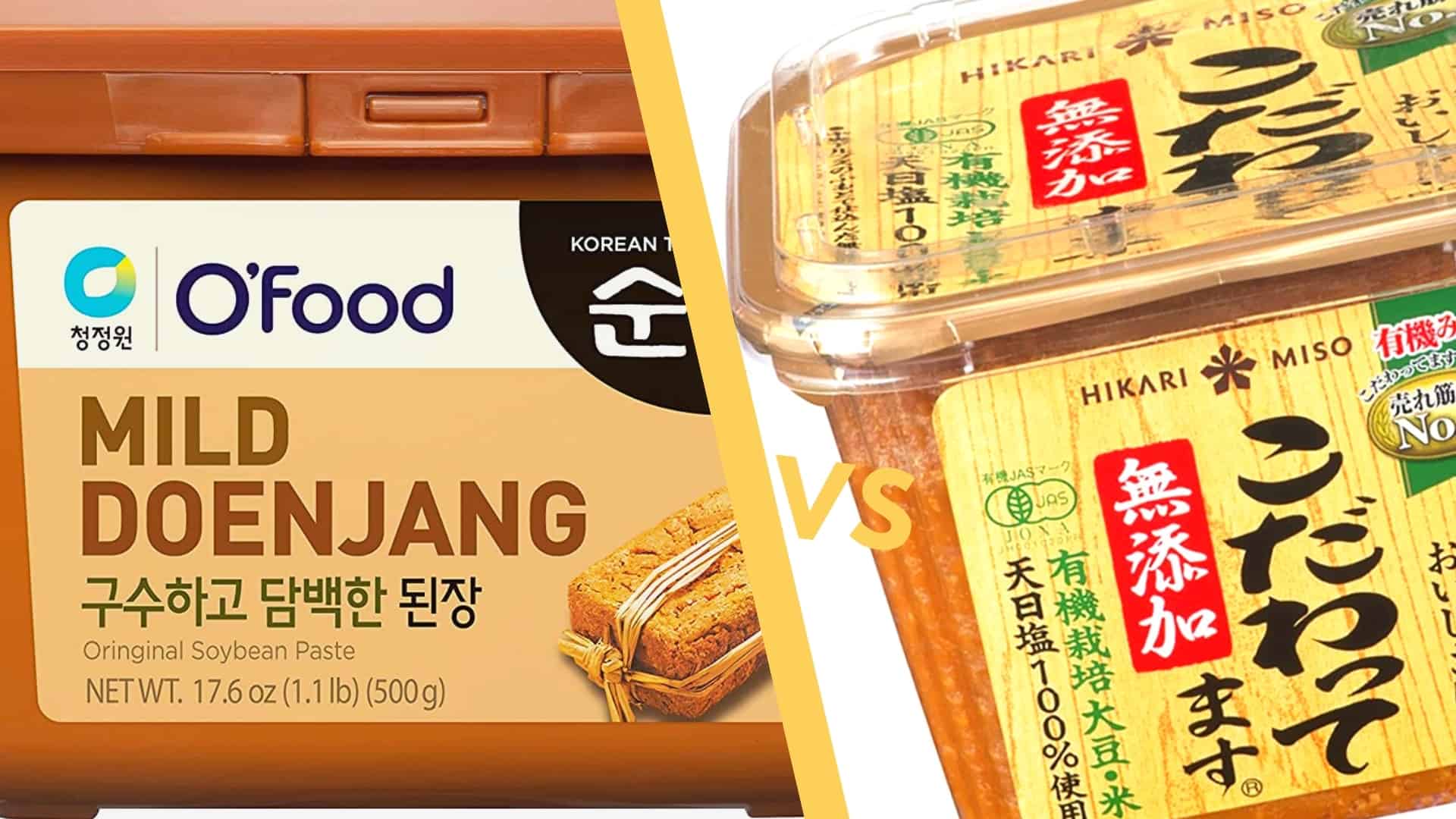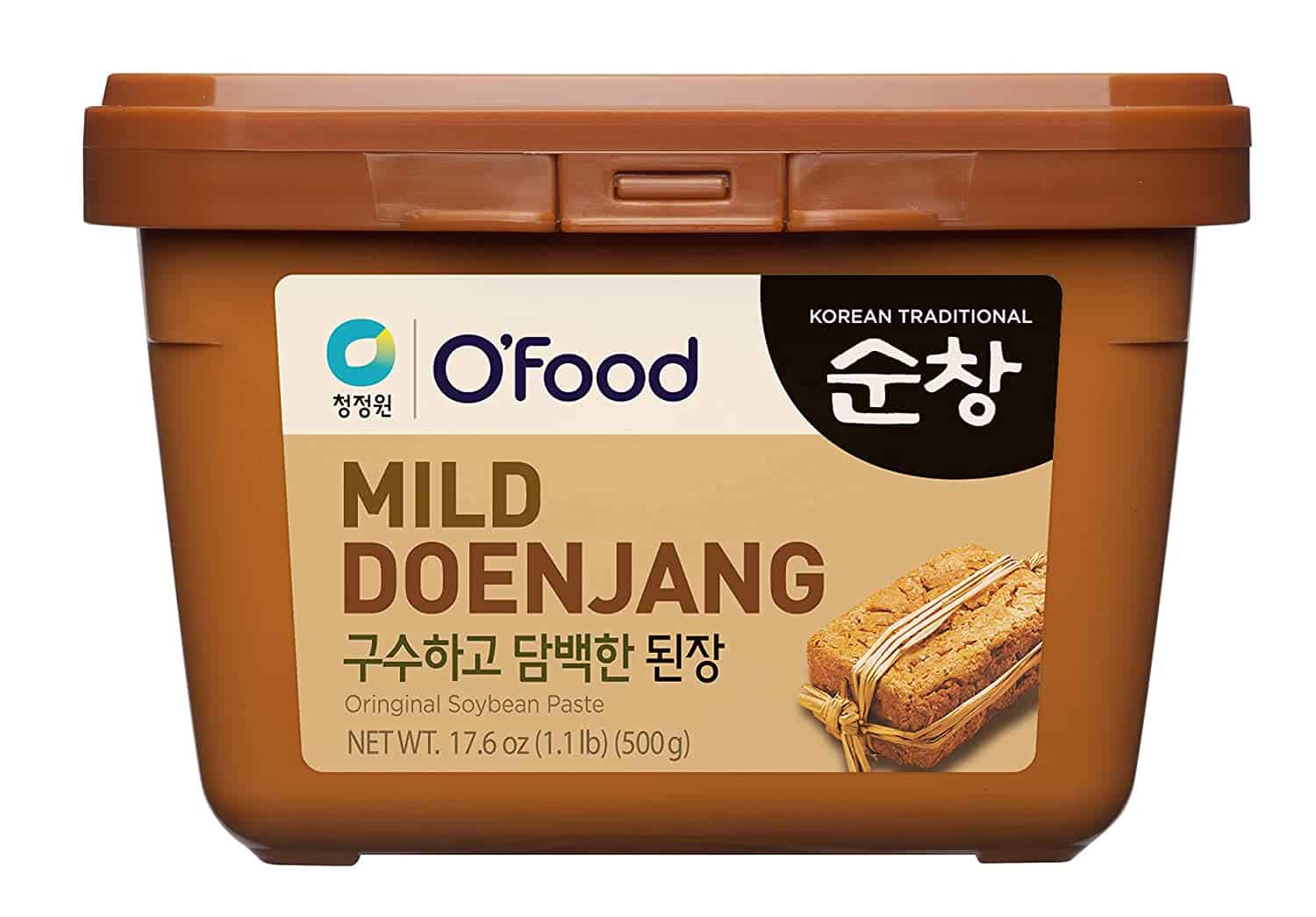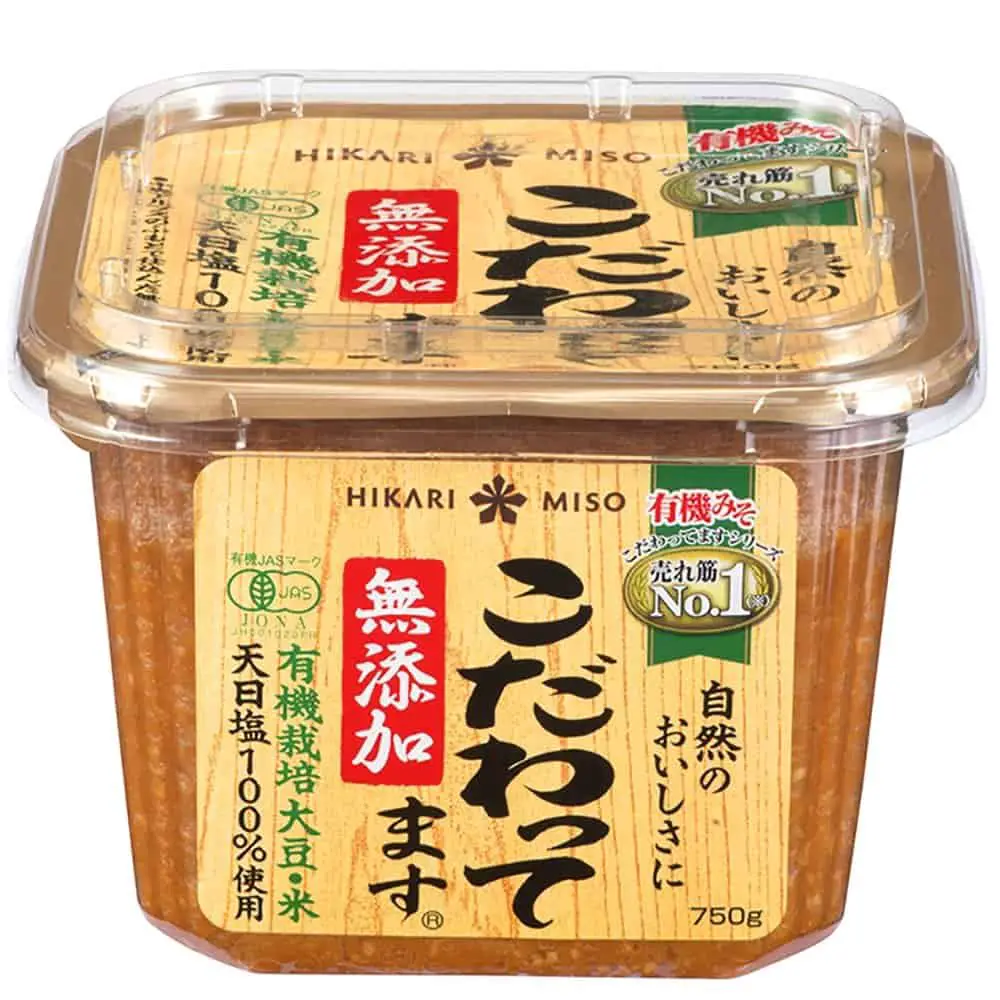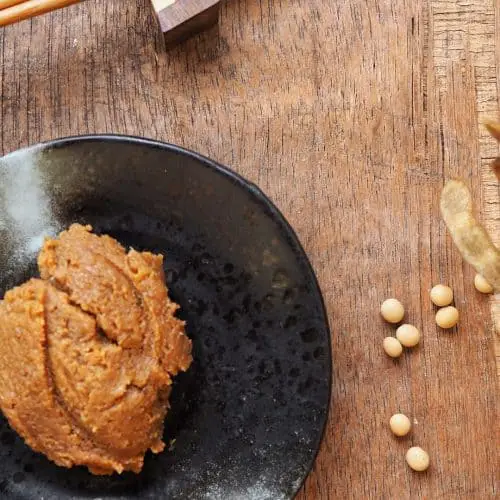Miso vs Korean soybean paste (doenjang): 3 odd ways to tell the difference
You’re probably wondering what the difference is between miso paste and Korean soybean paste (doenjang).
These both are fermented soybean pastes that are very similar in flavor and texture.
However, they aren’t exactly alike!

Soybean paste, called Korean doenjang or Chinese doujiang, has a more pungent smell and stronger taste than Japanese miso. Soybean paste doesn’t use grain as the fermentation starter and uses 3 fermentation processes to get a finished paste, whereas miso uses rice or barley with koji mold to start fermentation.
I’ll get more into each of these pastes, but to sum it all up, here’s a list of the main differences between soybean and miso paste.
| Soybean paste | Miso paste |
|---|---|
| Made purely of soybeans and saltwater | Uses rice or barley with a koji mold as the base |
| Has 3 fermentation stages and is fermented in the open air at all stages | Fermentation occurs on the grain first and has 2 fermentation stages, where the second stage occurs without oxygen present |
| Boiled and mashed soybeans are added right from the start and are the base of fermentation | Boiled and mashed soybeans are only added at the second stage, after the rice or barley has had time to ferment |
A lot of people often get confused between doenjang and miso. Both are soybean pastes, with one originating in Korea (doenjang) and the other coming from Japan (miso).
Despite both being from different cultures, the method of preparation and the main ingredients are similar. However, there are a few key differences.

Check out our new cookbook
Bitemybun's family recipes with complete meal planner and recipe guide.
Try it out for free with Kindle Unlimited:
Read for freeIn this post we'll cover:
Differences between doenjang and miso paste
While both these foods are made using fermented soybeans and salt, a few ingredients set them apart and give different flavors.
Typically, traditional Korean doenjang is made using only soybeans and salt. Whereas, in the case of miso, it’s made by adding a koji starter to rice along with the soybeans. As a result, miso tastes sweeter.
However, that’s not the only difference.
Depending on the grain used, there are several different kinds of miso. There’s black miso, which has an almost fudge-like texture, and then there are lighter, creamier shades as well.
Whereas doenjang has a sharper, more robust, and complex flavor profile!


Benefits of each
Thanks to miso and doenjang being fermented soybean paste, they’re perfect for the gut. Both foods have anti-obesity, anti-diabetic, anti-cancer, and anti-inflammatory properties.
Doenjang
Doenjang has been a staple of Korean food for centuries. It’s now becoming increasingly popular due to its many health benefits.
- Lowers blood pressure: The presence of histamine-leucine amino acid in doenjang is very effective at enhancing the activation of proteins. That helps lower blood pressure and cholesterol levels.
- Strengthens liver: Traditional doenjang is known to play a role in detoxifying the liver, reducing the activation of glycosyltransferase.
- Aids digestion: Any kind of fermented food is really good for the gut and helps aid digestion. A traditional Korean remedy for indigestion is having thin doenjang soup.
Miso
- Rich in essential minerals: Miso is a good source of various vitamins, including B vitamins, vitamins E, C, K, and folic acid. It’s a staple in Japanese cuisine thanks to its nutritional value!
- Beneficial for gut health: Thanks to the fermentation process, miso provides the gut with lots of beneficial bacteria that help keep you healthy.
Also read: does miso expire and how do you store it?
How to use doenjang and miso paste
Doenjang
Doenjang is used in various Korean dishes and is used as a dipping sauce for both meat and vegetables. It’s also used as the main ingredient in a variety of different soups.
When it comes to Korean BBQ, you simply can’t have it without doenjang!
Miso
Similar to doenjang, miso is also widely used in a wide variety of dishes. Miso soup is incredibly popular, and miso-glazed meats are starting to increase in popularity!
What is miso paste?
Miso paste is made from fermented soybeans mixed with salt and koji, a mold used to make sake. But it also contains barley, rice, or other grains.
The mixture ferments for a long time, anywhere from a couple of months to a couple of years.
The longer it ferments, the richer the flavor becomes.
Different types of miso
There are 3 main different types of miso. They vary according to the amount of time they are left to ferment:
- White miso: White miso is light in color and mild in flavor.
- Red miso: Red miso is left to ferment a little longer. As a result, it gets salty and develops a richer flavor and color.
- Mixed miso: Mixed miso is a combination of red and white miso. The 2 types complement each other perfectly.
Most people associate miso paste with miso soup. When mixed with dashi, it makes a delicious soup that’s nutritious and flavorful.
However, the paste can also be added to dishes to provide a rich, umami flavor that’s great in dressings and marinades.
It works well with fish and it can even add a unique richness to chocolate and caramel desserts.
No miso paste at hand, but a recipe that calls for it? Read: Miso paste substitute | 5 options you could add to your dish instead.
Miso paste nutrition
Miso paste is high in vitamins and minerals like B vitamins, vitamins E and K, and folic acid.
Because it’s fermented, it works as a probiotic with beneficial bacteria that improve gut health, which can boost mental and physical wellness!
The fermentation process also makes sure miso paste doesn’t expire that quickly.
What is soybean paste?
Soybean paste is most commonly called doenjang, and it’s a fermented bean paste made of soybean and brine.
Soybeans are soaked overnight and then coarsely ground and shaped into a cube. The cubes are cooled and dried.
Once they harden, they’re left to ferment for several months in earthenware pots. But unlike with miso, the lids are kept off so air can get to it. This is the second round of fermentation.
After about 90% of the moisture is removed from the paste (which is used to make a light soy sauce), it’s put back into the pots to ferment for a third time.
How to use soybean paste
Soybean paste is commonly used to produce soybean soup and it can also be used as a relish. It’s eaten as a condiment for vegetables and for dipping.
It can also be mixed with garlic and sesame oil to produce ssamjang, which is traditionally eaten in leaf vegetables and often served as a complement to popular Korean meat dishes.
Soybean paste nutrition
Because soybean paste is fermented, it’s beneficial to the digestive system. It’s also rich in flavonoids, vitamins, minerals, and plant hormones, which are known for being anti-carcinogenic.
Soybean paste is also rich in the essential amino acid lysine and the fatty acid linoleic acid, which play an important role in the normal growth of blood vessels and the prevention of blood vessel-related illness.
Recipes with miso paste and soybean paste

Miso soup recipe
Ingredients
- 4 cups vegetable broth (or dashi for a more authentic taste)
- 1 sheet nori (dried seaweed) cut into large rectangles
- 3-4 tbsp miso paste
- ½ cup green chard chopped
- ½ cup green onion chopped
- ¼ cup firm tofu cubed
Instructions
- Place vegetable broth in a medium saucepan and bring to a low simmer.
- While broth is simmering, place miso into a small bowl. Add a little hot water and whisk until smooth. Set aside.
- Add chard, green onion, and tofu to soup and cook for 5 minutes. Add nori and stir.
- Remove from heat, add miso mixture, and stir to combine.
- Taste and add more miso or a pinch of sea salt if desired. Serve warm.
Looking for more miso paste inspiration? We also have a great recipe here: Vegan miso soup with noodles: make dashi & miso from scratch.

Pork belly and soybean paste recipe
Ingredients
- 3-4 slices pork belly cut into big pieces
- ½ potato thinly sliced
- ½ zucchini cut into thin slices
- ¼ cup white onion chopped into small pieces
- 2-3 slices ginger
- 2 cloves garlic sliced
- 2 stalks green onion chopped for garnishing
- ¼ tsp sugar
- touch of sesame oil
Instructions
- Pan fry pork belly for 3-4 minutes until brown and crisp. Set aside.
- Add potato, onion, and zucchini into pan. Stir fry for 4-5 minutes under medium-high heat until soft.
- Toss in ginger and garlic, and pour 1 cup of water into the pan. Stir to mix well.
- Once water starts to boil, add soybean paste and sugar. Stir to mix well.
- Turn flame to medium-low heat and simmer for about 10 minutes with the lid on, stirring occasionally.
- Add pork belly to pan and cook an additional 2-3 minutes.
- Remove from pan and transfer to large serving bowl.
- Drizzle with sesame oil, sprinkle with green onion, and serve.
Now that you know the difference between soybean paste and miso paste, which will you be adding to your dishes?
Also read: these are the differences between Japanese and Korean food
Check out our new cookbook
Bitemybun's family recipes with complete meal planner and recipe guide.
Try it out for free with Kindle Unlimited:
Read for freeJoost Nusselder, the founder of Bite My Bun is a content marketer, dad and loves trying out new food with Japanese food at the heart of his passion, and together with his team he's been creating in-depth blog articles since 2016 to help loyal readers with recipes and cooking tips.
